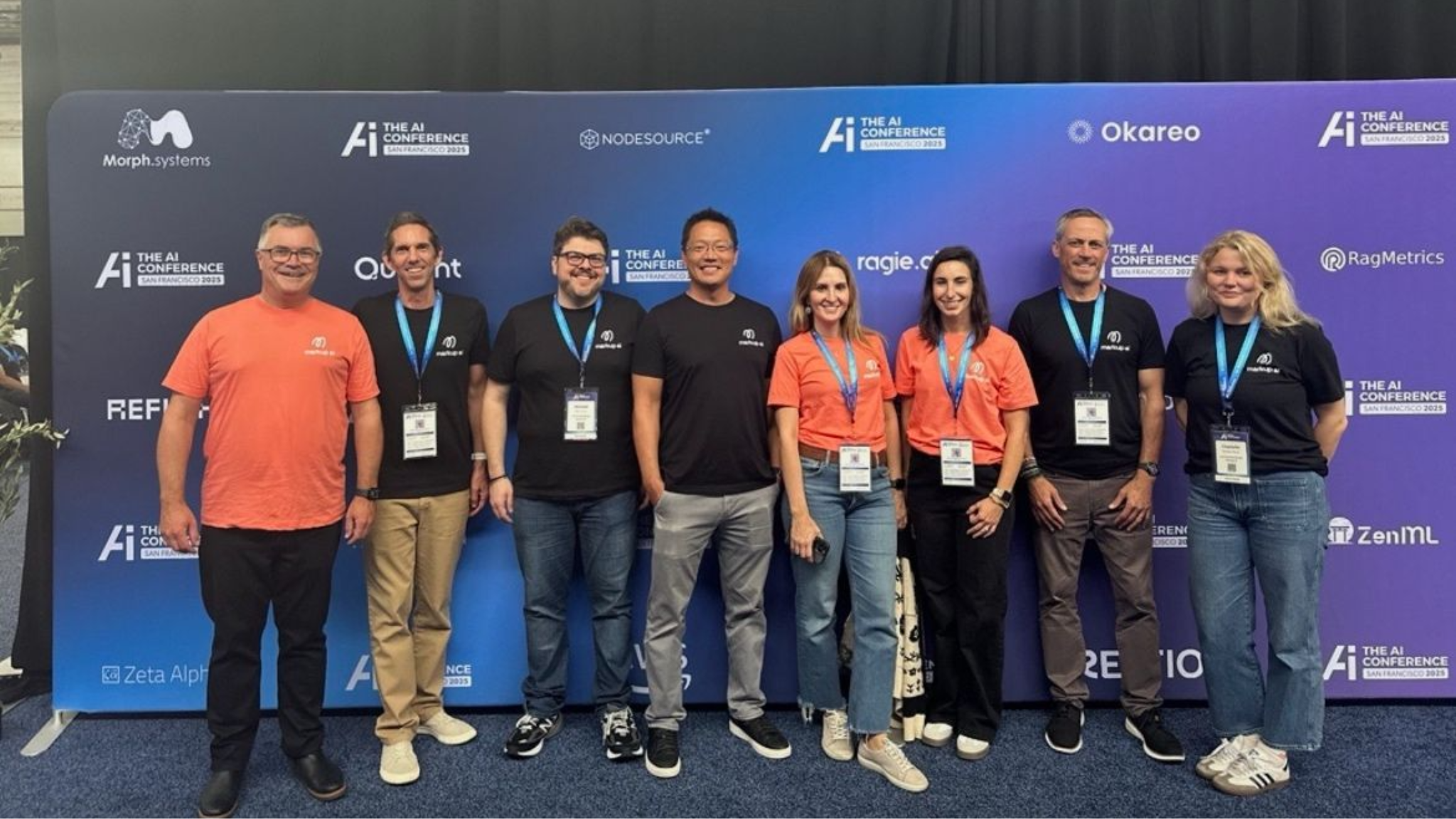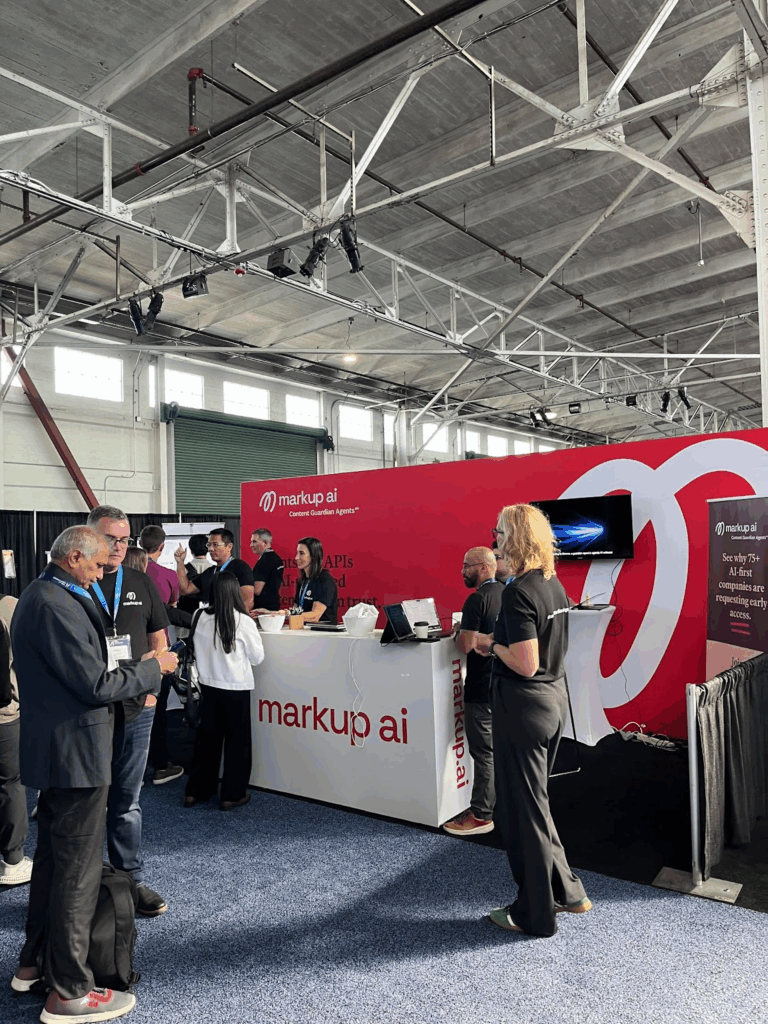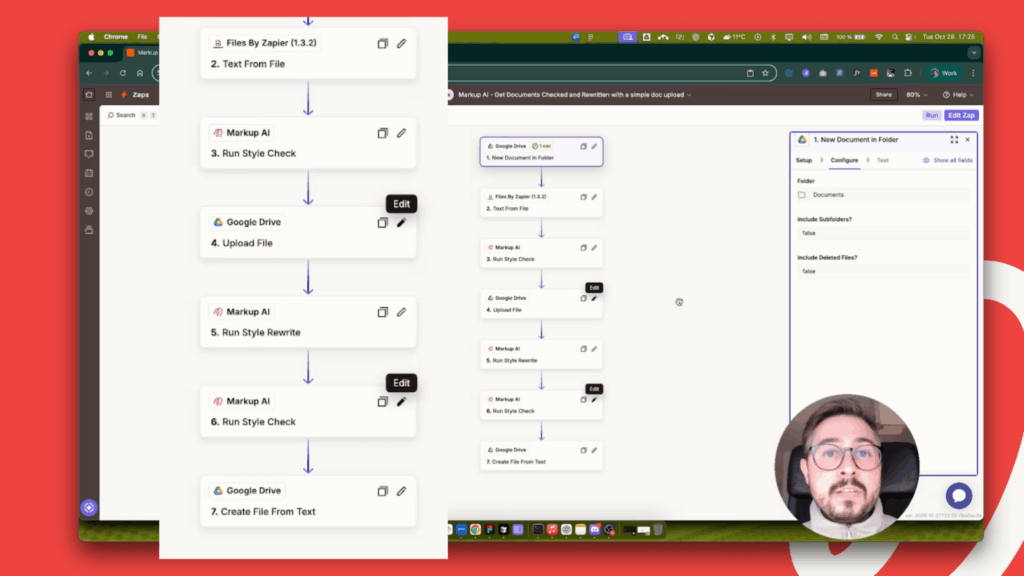The AI Conference 2025 in San Francisco: 5 things to take with you

Earlier this month, some of the brightest and most innovative pioneers in the AI space gathered to share research, ideas, and observations on the future direction of AI — and Markup AI was fortunate enough to be a key part of it.
What’s Markup AI? Hear from our CEO, Matt Blumberg.
We all know this by now, but AI is no longer a concept or “nice-to-have” if you work in the enterprise space. It’s a daily reality, and one that we must adapt to accordingly. This was a consistent theme at The AI Conference 2025 in San Francisco.
The question isn’t whether or not large organizations should encourage employees to leverage artificial intelligence; it’s: How do they implement AI initiatives safely and at scale?
Keep reading and discover five takeaways from The AI Conference that you can use to navigate the future of your enterprise content!
5 takeaways from The AI Conference 2025
While the sessions and panel discussions covered a wide range of AI-centric topics, a few central themes emerged as critical for any enterprise looking to stay ahead. These were:
- The end of the AI pilot paradox: The industry is moving past failed AI experiments toward tangible, real-world ROI.
- From monoliths to purpose-built AI: Enterprises are shifting from one-size-fits-all models to smaller, more secure, custom AI.
- The centrality of data governance: Without robust data governance, even the most advanced AI will underperform.
- The rise of coordinated AI systems: The emergence of agentic AI creates an urgent need for consistency and control.
- Bridging the Content Trust Gap: A commonly overlooked risk — off-brand or non-compliant content — requires a specialized solution.
Unable to attend the event? Access publicly available slide decks here!
1. The end of the AI pilot paradox
While many enterprises are still grappling with siloed data and capability gaps, it’s clear that the focus has shifted. The industry is growing out of the 95% AI pilot failure rate and toward tangible, real-world ROI.
The new imperative isn’t just about using AI, but about implementing it in a way that delivers scalable business value from day one. This requires a strong data governance foundation and a clear strategy to bridge the gap between initial promise and production reality.
For enterprise content writing and technical documentation teams, this means having a plan in place to ensure that AI-generated content can meet brand and compliance standards from the onset.
A powerful real-world example of this was presented by Satyanandam Kotha, a Staff Software Engineer at Uber. His talk detailed a cutting-edge distributed system for real-time fake review detection, which achieved a remarkable 0.94 precision score and average detection latencies of under 100 milliseconds. This practical application of AI, which leverages streaming data pipelines and a hybrid detection model, serves as a clear example of moving beyond initial promise to scalable business value.
2. From monoliths to purpose-built AI

Another common theme across the conference: We can’t rely on a single, massive LLM for every use case. There’s a clear shift toward creating smaller, highly accurate, and more accessible custom models for specific use cases. This move is driven by the need for greater control, enhanced security, and a better alignment with unorthodox business needs.
The emphasis is on building AI that is not just powerful, but also private and purpose-built to handle sensitive enterprise data and specialized workflows. This is where Markup AI’s API-native approach provides a powerful solution, enabling developers and content teams to easily integrate intelligent guardrails directly into their custom-built AI applications.
3. The centrality of data governance
Data isn’t just the bedrock of AI success; it’s the single most important factor determining whether AI implementation fails or succeeds. A resounding theme was that without a unified view of accurate, trusted, and connected data, even the most advanced AI models will underperform. Robust data governance, privacy safeguards, and ethical standards are now non-negotiable for any organization aiming for reliable and scalable AI adoption.
Markup.AI helps enforce this critical layer of governance by providing real-time scoring and rewriting capabilities, ensuring that every piece of content, whether human or AI-generated, meets your defined standards for content compliance.
Our CEO Matt Blumberg spoke about precisely this at the conference. In his presentation, he argued that while large language models are powerful content generators, they lack awareness of your brand, policies, and legal obligations. This flood of unmonitored content introduces serious vulnerabilities, from brand-damaging inconsistencies and off-message communications to costly regulatory violations. To confidently operationalize AI into action, companies need a new layer of defense: Independent AI guardian agents.
4. The rise of coordinated AI systems
The conference was abuzz with discussions about agentic AI — a glimpse into the future of enterprise software. This is a new paradigm where multiple, specialized AI agents work in orchestration to solve complex problems, a significant evolution from the single-task AI tools we use today. This sophisticated approach to problem-solving is driving incredible efficiency and innovation, but it introduces a new and pressing challenge: How to ensure consistency and control across these autonomous, coordinated systems.
This new level of AI complexity creates an urgent need for a “system of context” — a unified layer that ensures all agents operate with a shared, governed understanding of business rules and brand standards.
5. Bridging the content trust gap
A commonly overlooked risk — off-brand or non-compliant content — requires a specialized solution. As AI adoption skyrockets, a new kind of risk has emerged: Content that’s inaccurate, off-brand, or non-compliant. The “Content Trust Gap” refers to the disparity between the speed of AI content generation and the enterprise’s need for integrity. It’s a problem that requires intelligent guardrails to scan, score, and rewrite content in real-time.
This sentiment was powerfully echoed in a presentation by Daniyal Maniar, Software Engineer at Riot Games. He spoke on their use of audio large language models (LLMs) to detect trust and safety violations in voice chat for online games. Their approach to audio classification and the technical challenges of scaling these tools provide a clear example of how to build safer, more inclusive player experiences.
Their work demonstrates that addressing the content trust gap isn’t only a marketing or documentation concern, but a mission-critical function for ensuring brand safety and integrity in ALL forms of content.
What can you do to improve your AI content workflows?
The takeaways are great, but what can you actually do to ensure the AI content you’re generating is accurate, trustworthy, and built for the future of digital marketing? We’ve boiled down those takeaways into four actionable, future-proof tips:
- Develop a clear ‘System of Context’: Before you implement new tools, map out your existing content processes to identify where AI can provide the most value without disrupting your team. Then, establish clear rules, brand guidelines, and compliance standards for your AI to follow. Think of it as a style guide for machines.
Idea: Create a centralized knowledge base or a “source of truth” for your AI. This includes your brand’s style guide, a glossary of approved terminology, legal disclaimers, and a tone of voice document. This gives your AI a reference point, ensuring it doesn’t generate content that is off-brand or non-compliant.
- Do an audit to find content vulnerabilities: AI can scale your content output, but also amplify risks. Proactively identify areas in your content supply chain where AI-generated content may introduce errors or inconsistencies, and develop a plan to mitigate those risks.
Idea: Perform a simple content audit. Map the entire lifecycle of your content — from ideation to publication — and identify every point where AI is or could be used. For each of these points, ask: “What could go wrong here?” Look for potential factual errors, brand voice inconsistencies, or legal compliance gaps.
- Establish a human-in-the-loop process: While AI is powerful, human reviewers are crucial for ethical oversight and quality control. Building a feedback loop where human edits help train and refine your AI’s output is the best way to ensure trust.
Idea: Implement a simple review-and-approve workflow. Tag AI-generated content that needs to be reviewed by a human expert. Use a collaborative platform where your team can leave comments and make edits. The edits themselves become a valuable dataset that you can use to continually fine-tune your AI model.
- Prioritize API-first tools, like Markup AI: Instead of buying a single, closed platform that promises to do everything, invest in AI solutions with robust APIs. This allows you to integrate and orchestrate different models, ensuring your strategy remains flexible and scalable.
Markup AI takes content review to a deeper level. Our Content Guardian Agents℠ are designed to provide an extra layer of safety in your AI workflows, offering real-time scoring and instant rewriting via a simple API call. This allows you to scale your content operations safely, maintaining content integrity and reducing the risk of brand damage, regulatory issues, or factual errors.
As every industry rushes to integrate AI, your competitive edge lies not in sheer volume, but in a deeper level of governance and content integrity. Don’t just participate in the AI revolution – lead it. Be the one who ensures every piece of content is trustworthy and on-brand with Markup AI.
Check out our LinkedIn page for more post-conference updates and event photos!
Last updated: October 8, 2025
Get early access. Join other early adopters
Deploy your Brand Guardian Agent in minutes.





